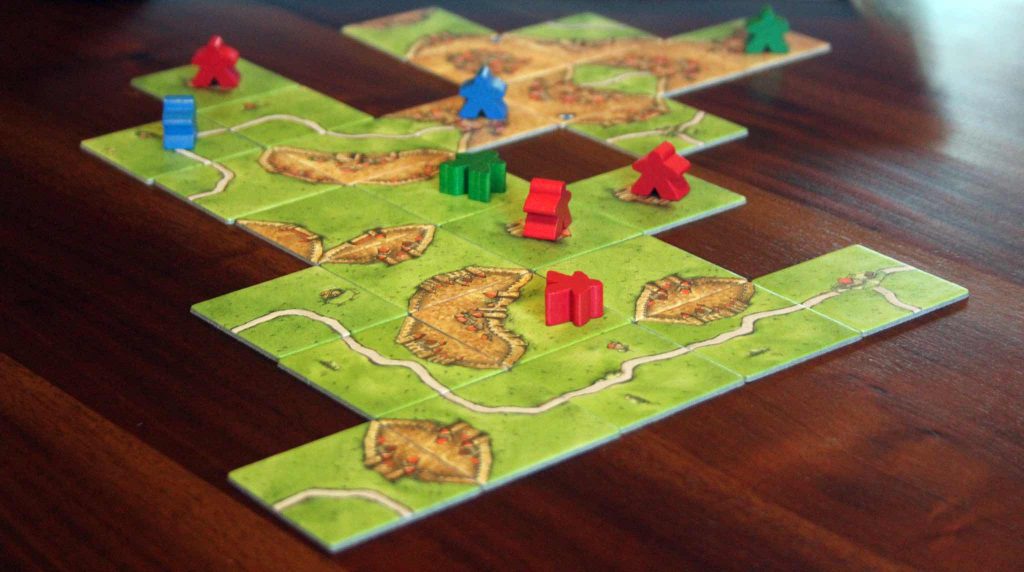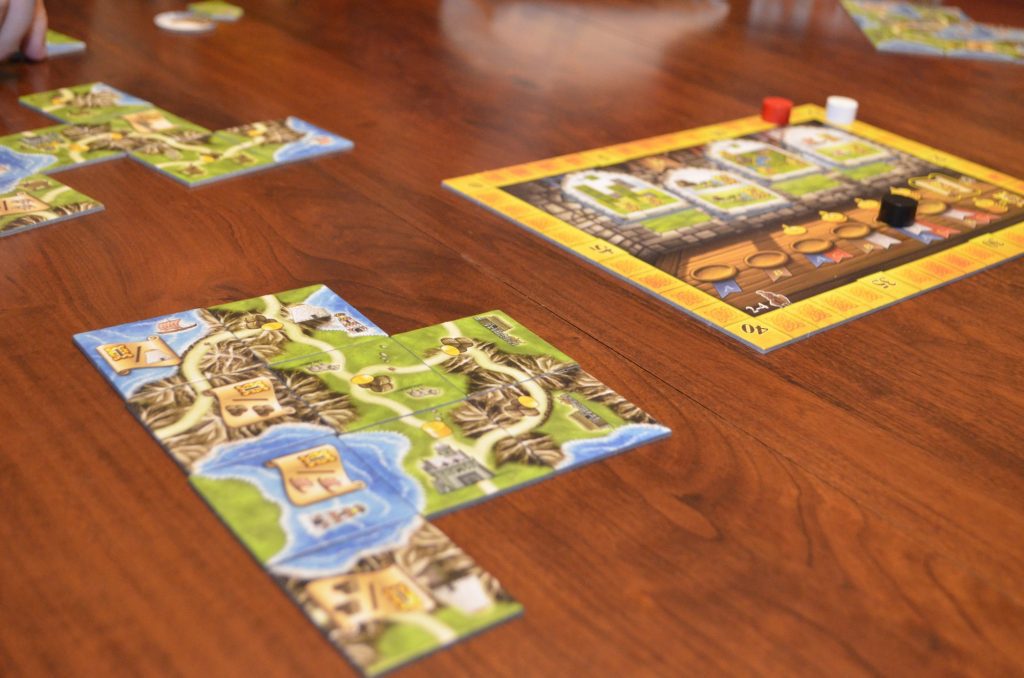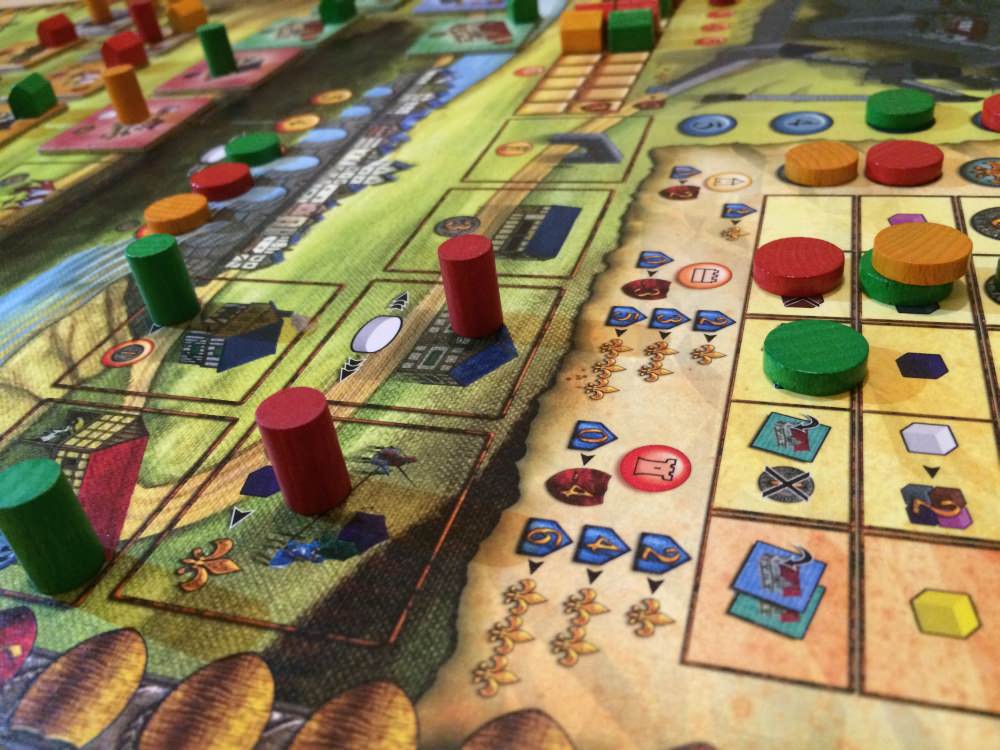For a lot of board gamers out there, we’ve got shelves full of games that we’ve picked up at places like Target or Barnes & Noble – each representing a different play style and different mechanics. The question is: where do you go next? If you like Game A, then what other game should you get to build upon that? Well, in this article, we are going to attempt to help you through that decision making process.
 Each group of games that we present here begin with a game that’s pretty standard and fairly easy to find. Then, we follow that up with other games that take the concepts and core mechanics the first game presents and then build upon or improve them. As you climb the ladder, the games become more involved and more challenging. So, let’s begin with:
Each group of games that we present here begin with a game that’s pretty standard and fairly easy to find. Then, we follow that up with other games that take the concepts and core mechanics the first game presents and then build upon or improve them. As you climb the ladder, the games become more involved and more challenging. So, let’s begin with:
Carcassonne → Isle of Skye → Suburbia
Carcassonne
Carcassonne, for a lot of people, is one of their very first introductions to eurogames. It is also, for many, their first foray into tile laying games. The players take turns drawing tiles and playing them into the gaming area in order construct and complete various features in order to score points. Equal parts skill and luck of the draw, Carcassonne is a delightful game that plays very quickly and scales well with different player counts.

Isle of Skye
Isle of Skye takes the tile laying concept and builds on it. In Isle of Skye, each round of the game has a different, randomly selected set of scoring criteria. Instead of drawing a tile from a central supply and then adding it to the gaming area, players instead draw three tiles at a time, auction off two of them, and discard the third. The decision of which tile a player should purchase and add to their display is largely influenced by the scoring criteria of not just the current round, but future rounds as well.
Isle of Skye is an amazing game that challenges the players to carefully manage their money and also to balance their current gains with their potential future ones. It presents a level of strategizing and planning that make it an easy step up from Carcassonne. If you’d like to know more about this excellent game, check out our review of Isle of Skye.

Suburbia
Suburbia takes the tile laying mechanism and kicks it into overdrive. In Suburbia, players are building a city by purchasing and placing tiles into their player area. Each tile placed may affect the player’s reputation (how many points they score each turn) or their income. As your income and reputation increase, you’ll have more buying power which lets you build bigger and better buildings each round. There are two tricks to Suburbia that make it a challenging and interesting tile laying game.
First, there are both group end of game scoring elements and personal end game scoring. This forces you to balance what you’re doing with fending off your opponent, while always keeping in mind your own goals. Second, your tile placement can affect both your and your opponents’ scoring. Certain tiles score points based on all boroughs, others score based on adjacent tiles. This balance of discerning the value of a tile for you versus your opponent makes Suburbia a tantalizing challenge that any lover of tile laying games should check out.

Dominion → CLANK! → Orleans
Dominion
Dominion is often considered the grandfather of the deckbuilding genre. Each player begins the game with an identical set of cards and, throughout the course of the game, these cards are used to purchase new cards which are then added to their deck. As their decks grow and these cards start getting cycled, the players are able to purchase even better cards and pull of even more interesting card combinations in order to acquire the points that they will need in order to win the game. Dominion is a powerhouse of a game and has had a major influence on the board gaming industry spawning several expansions and inspiring many others to create their own deckbuilding games.

CLANK!
Clank! Takes the deckbuilding mechanic and improves on it by adding a board! In Clank! you are a burglar stealing loot from beneath a castle. Your deck of cards starts out meager, where you have some ability to move and fight off monsters you encounter. Over time you’ll acquire cards which let you move faster, fight harder, and buy more cards in your quest for treasures buried and kept deep beneath the surface. As you’re sneaking through the dungeon you need to be careful to not make too much noise, because there’s a dragon lurking down there.
Clank! does a fantastic job marrying deck-building with an interesting push your luck game. If you’re a fan of deck-builders but still want a board, check out Clank!

Orleans
If you’ve enjoyed deck building, but find the mechanism of purchasing cards and cycling through your deck growing a little stale, we recommend you check out Orleans. In Orleans you’re building a bag instead of a deck. On each turn, you pull a number of workers out of your bag. You then use groups of these workers to activate a variety of actions. These actions will let you acquire more workers and take an action associated with the type of worker you acquire, move around the board and place guildhalls, and generate resources amongst a variety of other actions. One of the most interesting actions you can take is hiring a craftsman which allows you to add new actions to your area. This simple mechanism allows you to create intricate engines to accompany the standard bag/deck building in Orleans.

Istanbul → Yokohama → Hansa Teutonica
Istanbul
Istanbul is a fun game about ruby acquisition. The players control a merchant (who’s managing a team of assistants) as they move throughout the markets of the titular Istanbul trying to acquire, trade, and sell the goods that they will need to obtain the rubies needed to win the game. Central to this game is the concept of route building. As the merchants move through the markets, they must deploy or collect their assistants in order to perform the actions of the tiles that they land upon. Poor planning could lead to wasted turns in which the players are stuck having to move across the board without any assistants available to them.

Yokohama
Yokohama takes the route building concept and turns it up to eleven. The route building is just as important in this game, but the effectiveness of the chosen tile is directly affected by the number of workers and buildings that have been deployed there on previous turns. As these tiles are used, the workers are removed from the board. Unlike Istanbul, a player cannot move through tiles on which they do not have any workers present, so it is critical that the players consider where they ultimately want to go and what they want to do and ensure they have a network of workers in place to ensure they are able to go there and do those things. This games also introduces a lot of new mechanics as well – set collection, resource management, economics, and contract fulfillment. Unlike Istanbul in which the endgame is determined by the first player to collect a certain number of rubies, Yokohama is a lot more open with many, many ways of collecting the victory points needed to pull off a win.

Hansa Teutonica
The goal of Hansa Teutonica is to control trade routes between cities. On your turn, players will be placing and moving cubes on the routes on the board with the goal of completing routes between cities. Players start out being able to take two actions, but this number can increase as the game progresses. These actions include placing a cube or disc on the board, moving up to two cubes, displacing an opponent’s cube or disc at a cost to you, or completing a route between two cities and either taking a bonus if that route is adjacent to the bonus, or placing a cube or disc into one of the route end points. Also, when you complete a route, anyone who has a cube or disc in one of the endpoints scores a point.
At the end of the game, players score points based on their largest connected route. Hansa Teutonica is a deep game with rich interlocking mechanisms, behind a veil of simple rules. It expands on the route building of Yokohama and Istanbul by incorporating a route completion mechanism with route interaction. The player interaction in the game, though it can be very direct, has levels of strategic depth where you may be baiting a player to displace your cubes to gain the bonuses.

Lords of Waterdeep → Caylus → Ora et Labora
Lords of Waterdeep
Lords of Waterdeep (LoWD), based in the Dungeons and Dragons universe, has the players taking on the roles of nobles in the city of Waterdeep as they hire adventurers and then send them out on quests in order to gain money and prestige. At the end of the game, the player with the most prestige wins the game. The game itself is comprised of a board with various action locations on it. When the players send their workers to these locations, they can acquire various good and resources.
At the beginning of the game, the available actions are fairly basic in nature, but as the players construct buildings and add to the city, the variety of available actions becomes much wider and much more varied. This city building aspect is central to the game. Each new tile is owned by whichever player built it and provides that player with benefits whenever other players use it. One of our favorite game mechanics is the worker placement mechanic and Lords of Waterdeep is an excellent introduction to the concept.
Read our review of Lords of Waterdeep.

Caylus
Caylus presents a different kind of challenge. The concepts of worker placement and ownership are still very important aspects of the game. Much like LoWD, the players take turns placing their workers onto the various action spaces in order to gain resources and points. These resources are used by the players to add various buildings from a central supply, which add new actions to the game, onto the board. Whenever someone uses a building that is owned by another player, the owner earns a benefit.
What sets Caylus apart, though, is its inherent “meanness”. Whenever a player passes, their passing causes the costs associated with performing actions to increase for the leftover players. Even more direct than this, though, is the Provost. The buildings in Caylus are arranged along a road that runs from one end of the game to the other. The Provost is a piece that can be moved up and down the road by either using a board action or paying some money. Unlike LoWD, actions are not carried out as soon as workers are placed onto the action space. Instead, they are carried out at the end of the round after the Provost has had a chance to move. Any actions that are on the road AFTER the Provost’s ending position are not carried out. This means that there will be many, many turns in which some players will have effectively wasted portions of their turn (if not the entire thing) because of the actions of the other players.
In terms of cutthroat-ness, Caylus is the worst offender on this list. It is not a friendly game by any means, but it is a very fun one and it’s a good step up from LoWD. However, in terms of difficulty, it’s definitely much easier to wrap your head around than the next game on our list.

Ora et Labora
Like the previous two worker placement games on this list, a large part of Ora et Labora (OeL) revolves around using your workers in order to collect resources to build things which are then used to generate new action spaces. And, just like the previous two games, utilizing another player’s action space will provide that player with some kind of benefit.
One thing that sets OeL apart from the other two games is that the locations on which you can build aren’t linear. Instead of having pre-determined building locations, OeL provides the players with a limited amount of space at the beginning of the game, forcing the players to have to purchase expansions and then clear these expansions of the forest growth and peat bogs that they come pre-populated with before they can make effective use of them. Also, whereas selecting a resource gathering location in the other games will net you the same amount of resources every time that you select that space, the resource allocation in OeL changes from one round to the next.
This resource allocation is tracked using a special rondel which also serves as the game timer. After a certain number of rotations, the game comes to an end and the players count up their victory points to determine the winner. Ora et Labora is a very complex game with a lot of pieces and many paths to victory. Each building is worth a certain amount of points and some even score points based on the buildings that surround them.
Some goods can be upgraded into more valuable goods that will provide victory points at the end of the game. And these are just a few examples of the various methods that players have of earning points. This is an oversimplification of this magnificent game which stands as an excellent example of everything that makes the worker placement mechanic such a popular one.

For Sale → The Speicherstadt → Power Grid
For Sale
No Top 6 Boardgame Step Ladder list would be complete without an auction/bidding game on there and no game out there is as good an introduction to the mechanic as For Sale is. In this game, there are two decks of cards – Property cards which are numbered from 1 to 30 and Check cards which are numbered from 0-15 with two copies of each Check card.
In the first phase of the game, the players are going to be taking turns bidding to gain control of one of four random cards that will be flipped up out of the Property cards deck. If a player passes, they get some of the money that they bid back and win the lowest card on the table. The winning player wins the highest card and loses all of the money that they bid. In the second phase, the players will be using their acquired properties to bid for Check cards that are randomly flipped up from the Check card deck. The person who reveals the highest valued Property card will receive the highest valued Check card. The second highest receives the second highest valued Check card, etc. When all of these cards have been won, the players add up their scores to determine the winner.
For Sale is a fairly simple game to learn and can be taught and played in a matter of minutes. But, don’t let its simplicity fool you. There’s a lot of game in that little box.

The Speicherstadt
The Speicherstadt takes the auction/bidding mechanic and elevates it by adding an extra level of player interaction, cleverness, resource management, and set collection into the mix. The game takes place over several rounds in which new cards will be introduced into the game. These cards are made up of cards that will produce resources and money, cards which will allow you to store resources for future use, cards which will gain you victory points at the game for every card of a specific type that you have collected, and several others. At the end of the game, the various victory points provided by these cards will determine the winner. These types of cards are nothing unique. Lots of board game have cards like these, but what really sets the game apart is the clever auction/bidding mechanic.
Each card is introduced into the game in a specific location. Above each of these locations is a track. The first player to bid on a card will place their meeple in the first empty space on the track. The next meeple sent to that track is next in line, so on and so forth. Players continue bidding on cards until they have placed all of their meeples. Then each track is considered one at a time to determine which player will win the card. The more meeples there are on the track, the more expensive the card will be. If those meeples are removed, the card becomes cheaper for the next player in line.
So, placing one of your meeples further back on the track means that you are, in effect, driving up the cost to buy the card while, at the same time, putting yourself in a position where someone else might purchase it before you. However, if you’re the last person on the track and everyone else has removed their meeples, then you could snag the card for the low, low price of $1. This clever juxtapositioning of the meeples on the various bidding tracks is where the real meat of The Speicherstadt takes place and it’s a whole lot of fun!

Power Grid
Power Grid builds a networking game around a vitally important auction. In Power Grid players are acting as competing power companies, attempting to provide power to cities. At the start of each round, players auction off power plants, which they will use to power their cities. In order to run, these power plants require differing amounts of good from an ever dwindling market. During the auction, players need to balance their personal needs, with what resources everyone else needs, with their position in the turn order track. Together, this makes Power Grid an amazing step up on the auction ladder, and a game that every gamer should try out.

Forbidden Island → Pandemic → Dead of Winter
Forbidden Island
Sometimes you might not want to compete against your friends. Sometimes you just want to sit down and enjoy a game without tempers flaring. Enter the cooperative game. Forbidden Island is one of the first co-ops that many gamers will ever encounter and it is also one of the easiest in terms of overall difficulty. In the game, the players are a group of adventurers who are tasked with working together to gather up all of the titular island’s treasures before the island sinks into the sea. Each character has a unique ability to help the players along. Even as the players are working together to succeed, the game is working against them. Each round, bad things happen that are out of the players’ control and it is how the players respond to these calamities that makes the game so fun! Forbidden Island is a very thematic team building experience.

Pandemic
Pandemic is much more punishing. Whereas Forbidden Island presents the players with relatively easy obstacles to overcome, Pandemic is much less forgiving. In Pandemic your goal is to cure four diseases that are ravaging the Earth before time runs out or the diseases overtake you. At the end of each turn, cards are drawn from an infection deck, which specifies what city the diseases spread to on that turn. The really interesting challenge of Pandemic is the escalation mechanism.
Throughout the players’ deck of cards, there are epidemic cards which have the players take all of the city cards they’ve drawn, shuffle them up, and place them on top of the deck, along with a few other nuances. This simple mechanism causes the game to escalate each time the players see an epidemic card. Players are forced to balance collecting cards, which are used to cure the disease, with jetsetting around the globe to quell outbreaks.
Pandemic is the classic co-op game for a reason. The design is elegant and simple, but the struggle is ever-present. As you’re playing, you’ll be tempted to meet up with your teammates to trade cards, but be constantly pulled in other directions to help with the disease fighting effort.

Dead of Winter
Dead of Winter is all about surviving the zombie apocalypse and is absolutely dripping in theme. Players have a mission which they must achieve as a team, such as kill 24 zombies, along with personal objectives like collecting medicine or weapons. Each round, the team needs to collect certain types of resources to keep the camp safe, along with fighting off the oncoming zombie horde as they try and enter your camp and the locations around it.
That all sounds easy enough right? But someone amongst you might be a traitor, and only they know. Dead of Winter is as much about deducing the alliances of each people you’re playing with as it is about bashing in zombies. If you like thematic games with tense moments, Dead of Winter is for you.

What do you think about our step ladders? Would you do something differently? Do you have your own step ladders to add? Let us know in the comments below!
Subscribe to our newsletter to receive periodic updates about news, articles, and contests.










